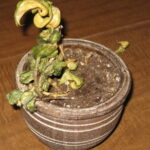With a few supplies and a sunny corner, it is possible to grow tropical fruit plants indoors no matter what zone you live in. For years, tropical plants have been carried around the world and added to private and public gardens, where they have flourished and borne fruit. Growing these plants is not as difficult as you might think, but there are some fruit plants that are easier to grow indoors than others.
These plants do require a few more requirements that you otherwise not consider with ordinary houseplants. The following five are the easiest and most successful tropical fruit plants to grow indoors, but they also make a beautiful addition to every patio garden when the weather is warm enough.
Pineapple
One of the easiest tropical fruit plants to grow is the pineapple, and it is even possible to start your own plant. Pineapple plants are easy to contain, do not require a lot of space and can easily be moved outdoors and then back inside during the winter months. If you purchase a young plant, you can have pineapples growing and ready to eat within a year, if you grow your own plant, you will still be able to enjoy pineapples in two to three years. To grow your own plant, place the crown of a store bought pineapple under one inch of potting soil in a twelve inch pot. Water thoroughly, but allow the soil to dry completely between each watering.
Star Fruit Tree
Star fruit is one of the more exotic tropical plants you can grow, but new varieties have made it incredibly easy to grow these trees indoors in exceptionally sunny windows. There are some varieties that grow better than others, but the Dwarf Maher is the most popular with indoor and greenhouse growers. Regular pruning will encourage a bushy tree and this also serves to make it easier to keep in the home. Regular sunlight and a warm location are necessary for the Star Fruit Tree to bear fruit, so as soon as the weather begins to cool down outside, bring it indoors and place in a spot that is at least seventy five degrees Fahrenheit.
Papaya Tree
In the wild, and on farms, papaya trees grow to incredible heights, with fruit that can be as much as five pounds. Growing a tree in your home is very different, because there are new varieties of the tree that are meant to stay short, adapt well to the container they are in and bear fruit rather quickly. When you get your tree, plant it in the container that you plan on allowing it to grow into over the next couple of years. Papaya are the type of plant that will grow and bear fruit according to the limitations it is given. It is also a great idea to add a source of heat to the soil, check your local nursery, if you live further north or keep the tree in an area where it might be exposed to some cool air. Expect fruit within a year under the best conditions.
Fig Tree
The fig tree has been adapted into a bush over the years so that it is now easier to grow it indoors and can even survive as far North as Zone 6 outdoors with some wintering. Even so, it is a good idea to grow in a container because an especially hard winter can kill the tree, this way you have the flexibility of bringing the tree indoors to keep its leaves during the winter or puled into a garage or shed where it will shed its leaves and then bloom again in the spring. The fig tree does require protection from harsh winter wind and mulch on the ground to keep the roots alive. Chicago Hardy and Black Mission are two varieties that are easier to find and known for their hardiness and bountiful branches.
Avocado Tree
Almost everyone has recovered an avocado pit in the attempt to grow a tree as a child, and it certainly does work, but these plants hardly ever bear fruit and if they do it will not be what you expect. Instead opt for a grafted plant that you can find at specialty nurseries, and immediately repotted when you get it home. With just three to five feet of growth, these trees are easily at home in a sunny window year round, though it is ideal to pull them outside during their fruit bearing months, slowly acclimating them to the sun and weather. Fruit can be expected after about two to three years of growth and depending on the variety, fruit will ripen between sixty and ninety days.



